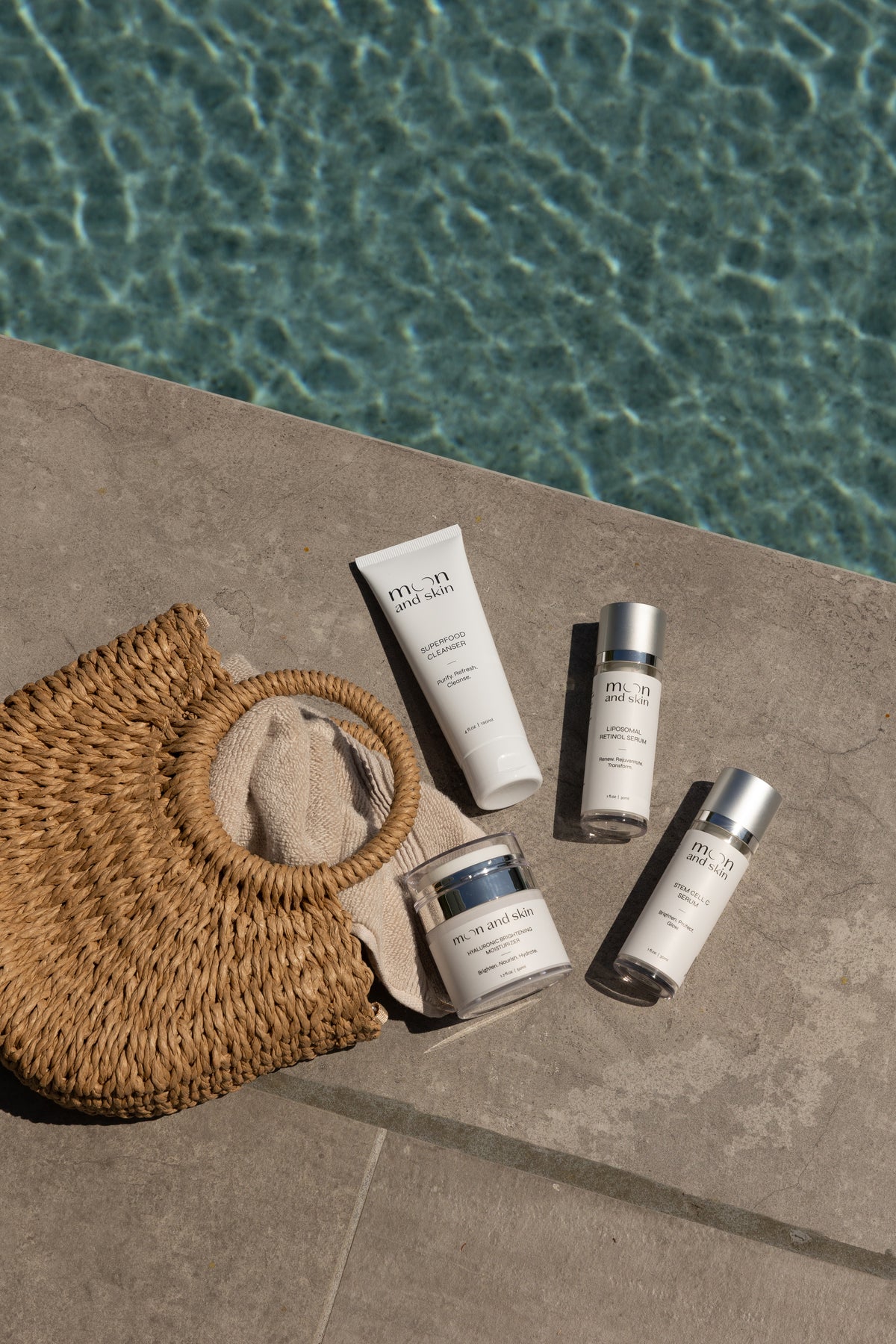Table of Contents
Introduction
Are you constantly battling dry, flaky skin that feels tight and uncomfortable? You’re not alone. Studies show that nearly 40% of adults experience some form of dry skin, particularly during colder months when humidity levels drop. But fear not! We’re here to help you navigate the world of skincare and create an effective daily skin routine tailored specifically for dry skin.
At Moon and Skin, we understand that every skin type has unique needs, and dry skin requires special attention. Our mission is to provide clean, thoughtful skincare for every phase of life, and that starts with education and empowerment. In this blog post, we’ll explore the characteristics of dry skin, key ingredients to look for in your skincare products, and walk you through a comprehensive daily skincare routine designed to hydrate, protect, and rejuvenate your skin.
By the end of this post, you’ll have the knowledge and confidence to embrace a skincare routine that nurtures your skin's health and vitality. Together, let’s transform your dry skin into a hydrated, radiant canvas.
Understanding Dry Skin
What is Dry Skin?
Dry skin, also known as xerosis, occurs when your skin loses its natural moisture. This can lead to a range of uncomfortable symptoms, including a tight sensation, flakiness, and in some cases, even cracking. The skin barrier, which helps retain moisture, can become compromised, making it essential to choose products that not only hydrate but also protect and repair this barrier.
Causes of Dry Skin
Several factors can contribute to dry skin:
- Environmental Factors: Low humidity, cold weather, and hot, dry air can strip moisture from the skin.
- Harsh Cleansers: Products that contain alcohol or harsh chemicals can damage the skin barrier and lead to dryness.
- Hot Showers: Prolonged exposure to hot water can dehydrate the skin.
- Aging: As we age, our skin produces less oil, leading to increased dryness.
- Underlying Health Conditions: Conditions such as eczema or psoriasis can exacerbate dry skin.
Signs of Dry Skin
Identifying dry skin is crucial for establishing an effective skincare routine. Common signs include:
- Flaky patches
- Redness or irritation
- Tightness, especially after washing
- Rough texture
- Itching
If you recognize these signs, it’s time to prioritize hydration in your skincare routine.
Key Ingredients for Dry Skin
When it comes to treating dry skin, the ingredients in your products matter significantly. Here are some key ingredients to look for:
- Hyaluronic Acid: A powerful humectant that attracts moisture to the skin and helps retain it. Our Hyaluronic Brightening Moisturizer is formulated with this ingredient to boost hydration and brighten your complexion.
- Glycerin: Another excellent humectant that draws moisture into the skin and helps maintain its barrier.
- Ceramides: Lipids that help restore the skin barrier and retain moisture. They are essential for maintaining healthy skin.
- Dimethicone: A silicone-based ingredient that provides a protective barrier on the skin, helping to lock in moisture.
- Shea Butter: Rich in fatty acids, shea butter hydrates and nourishes the skin, providing a soothing effect.
- Vitamin E: An antioxidant that helps protect the skin from environmental damage while promoting moisture retention.
By incorporating products that feature these ingredients into your daily skincare routine, you’ll be well on your way to achieving smooth, hydrated skin.
Step-by-Step Daily Skin Routine for Dry Skin
Creating a daily skin routine for dry skin involves several essential steps. Each step is designed to cleanse, hydrate, and protect your skin effectively. Let’s break it down.
Step 1: Cleansing
A gentle cleanser is crucial for removing dirt and impurities without stripping the skin of its natural oils. We recommend using our Superfood Cleanser, which is formulated with HydroProtein Technology to nourish and hydrate while cleansing.
How to Use:
- Use lukewarm water to wet your face.
- Apply a small amount of the cleanser and gently massage it onto your skin in circular motions.
- Rinse thoroughly and pat your skin dry with a soft towel.
Step 2: Hydrating Serum
After cleansing, it’s time to boost hydration with a serum. Our Stem Cell C Serum not only provides hydration but also brightens the skin and protects against environmental stressors.
How to Use:
- Apply a few drops of serum to your fingertips.
- Gently press the serum into your skin, focusing on areas that feel particularly dry.
Step 3: Moisturizing
Locking in moisture is critical for dry skin. Our Hyaluronic Brightening Moisturizer is perfect for this step as it deeply hydrates while brightening your complexion.
How to Use:
- Take a dime-sized amount of moisturizer and apply it evenly across your face.
- Don’t forget to include your neck and décolletage.
Step 4: Sun Protection
Protecting your skin from UV damage is vital, even if you have dry skin. A broad-spectrum sunscreen should be a non-negotiable part of your routine. Look for formulas that hydrate while providing sun protection.
How to Use:
- Apply sunscreen every morning as the last step in your skincare routine.
- Make sure to cover all exposed areas, including your face, neck, and ears.
Evening Routine
Your evening routine will follow a similar structure but with a few adjustments to enhance hydration and repair.
Step 1: Cleanse (same as morning)
Step 2: Night Serum or Treatment Consider using our Liposomal Retinol Serum at night to promote cell turnover and enhance skin texture.
Step 3: Rich Night Cream Use a thicker moisturizer or overnight mask to further nourish your skin while you sleep.
Additional Tips for Managing Dry Skin
- Limit Hot Showers: Take short, lukewarm showers to avoid stripping your skin of moisture.
- Use a Humidifier: Adding moisture to the air can help prevent your skin from drying out, especially in winter.
- Stay Hydrated: Drink plenty of water throughout the day to keep your skin hydrated from within.
- Choose Fragrance-Free Products: Fragrances can irritate dry skin, so opt for fragrance-free options whenever possible.
- Exfoliate Gently: Use mild exfoliants 1-2 times a week to remove dead skin cells without irritating your skin.
Conclusion
Creating a daily skin routine for dry skin doesn’t have to be complicated. By choosing the right products and following a simple, structured routine, you can nourish and hydrate your skin effectively. At Moon and Skin, we believe in the power of clean, thoughtful skincare that aligns with your individual needs.
We invite you to explore our Bundle & Save collection, where you can find all the essential products for your complete skincare routine at a better value. Let’s celebrate your skin’s journey together and empower you to achieve a radiant, healthy complexion.
FAQ
1. How often should I moisturize my dry skin? We recommend moisturizing at least twice a day—once in the morning and once before bed—to keep your skin hydrated.
2. Can I use makeup on dry skin? Yes, but it’s best to use hydrating foundations and avoid powders that can accentuate dryness.
3. Are there any foods that help with dry skin? Yes! Foods rich in omega-3 fatty acids, such as fish, nuts, and avocados, can help keep your skin hydrated.
4. How can I tell if my skin is simply dry or dehydrated? Dry skin lacks oil, while dehydrated skin lacks water. If your skin feels tight and appears dull, it may be dehydrated.
5. When should I see a dermatologist for my dry skin? If your dry skin is persistent, causes significant discomfort, or is accompanied by other symptoms, it's wise to consult a dermatologist for tailored advice.
By following this guide and using our thoughtfully crafted products, you can embrace a daily skincare routine that nurtures your dry skin and enhances your natural beauty. Together, let’s embark on the journey to healthier, hydrated skin!







